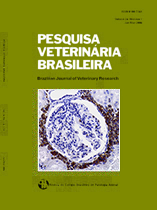 |
|
|
|
Year 2016 - Volume 36, Number 4
|

|
Classification of 86 bovine lymphomas cases according to the Working Formulation (WF) of Non-Hodgkin’s Lymphomas for Clinical Usage and The Revised European-American Classification of Lymphoid Neoplasms (REAL), 36(4):263-271
|
ABSTRACT.- Panziera W., Bianchi R.M., Faccin T.C., Galiza G.J.N., Lopes E.M.B., Kommers G.D. & Fighera R.A. 2016. [Classification of 86 bovine lymphomas cases according to the Working Formulation (WF) of Non-Hodgkin’s Lymphomas for Clinical Usage and The Revised European-American Classification of Lymphoid Neoplasms (REAL).] Classificação de 86 casos de linfoma em bovinos de acordo com a Working Formulation (WF) of Non-Hodgkin’s Lymphomas for Clinical Usage e The Revised European-American Classification of Lymphoid Neoplasms (REAL). Pesquisa Veterinária Brasileira 36(4):263-271. Departamento de Patologia, Centro de Ciências da Saúde, Universidade Federal de Santa Maria, Avenida Roraima 1000, Camobi, Santa Maria, RS 97105-900, Brazil. E-mail: anemiaveterinaria@yahoo.com.br
A retrospective study of 86 cases of bovine lymphoma classified as with diffuse pattern of distribution and verified by phenotypic (histology) and immunophenotypic (immunohistochemistry [IHC]) is presented. Regarding the size of the neoplastic lymphocytes, 83.8% was classified as large cells lymphoma and 11.6% as small cells lymphoma. Mixed lymphomas, i.e., formed by large and small cells simultaneously represented only 4.6% of all cases. Regarding their mitotic index, 84.9% of lymphomas was included in the intermediate-grade, 10.5% as low-grade and 4.6% as high-grade. Regarding the nucleus morphology, lymphomas with mostly non-cleaved cells (58.2%) or cleaved cells (37.2%) were the more frequent than those with a balanced mixed proportion of cleaved and non-cleaved cells (4.6%). Based on these results, the 86 lymphoma cases were classified by the Working Formulation (WF) of Non-Hodgkin’s Lymphomas for Clinical Usage as: diffuse large non-cleaved cell (46.5%), diffuse large cleaved cell (33.7%), diffuse mixed small and large cell (4.6%), diffuse small cell – plasmacytoid (7%), immunoblastic (3.5%), diffuse small cell – intermediate (2.3%), diffuse small non-cleaved cell (1.2%), and diffuse small non-cleaved cell Burkitt’s (1.2%). According to the IHC, 27 out of 86 (31.4%) lymphomas were positive to monoclonal antibody CD79αcy, used to detect B cells, and none were positive for polyclonal antibody CD3, used to detect T cells. Based on this, the 27 B-cell type lymphomas were distributed as follows: diffuse large B-cell lymphoma (81.5%), large cell immunoblastic lymphoma (11.1%), and lymphoplasmacytoid lymphoma (7.4%), according the Revised European-American Classification of Lymphoid Neoplasms (REAL). The results of this retrospective study, similar to what has been described in other parts of the world, allow us to conclude that bovine lymphomas are basically diffuse and predominantly made of intermediate-grade, large cells, with cleaved or non-cleaved nuclei. These lymphomas are due to neoplastic proliferation of B cells and correspond to almost all (92.6%) to what is currently classified as diffuse large B-cell lymphoma by REAL. |
| |
|
|
| |
|
 |